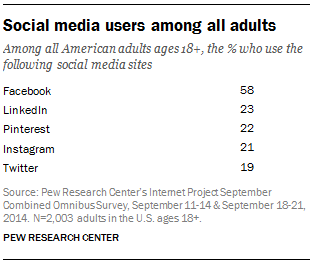 In a new survey conducted in September 2014, the Pew Research Center finds that Facebook remains by far the most popular social media site. While its growth has slowed, the level of user engagement with the platform has increased. Other platforms like Twitter, Instagram, Pinterest and LinkedIn saw significant increases over the past year in the proportion of online adults who now use their sites.
In a new survey conducted in September 2014, the Pew Research Center finds that Facebook remains by far the most popular social media site. While its growth has slowed, the level of user engagement with the platform has increased. Other platforms like Twitter, Instagram, Pinterest and LinkedIn saw significant increases over the past year in the proportion of online adults who now use their sites.
The results in this report are based on American adults who use the internet.1 Other key findings:
- Multi-platform use is on the rise: 52% of online adults now use two or more social media sites, a significant increase from 2013, when it stood at 42% of internet users.
- For the first time, more than half of all online adults 65 and older (56%) use Facebook. This represents 31% of all seniors.
- For the first time, roughly half of internet-using young adults ages 18-29 (53%) use Instagram. And half 0f all Instagram users (49%) use the site daily.
- For the first time, the share of internet users with college educations using LinkedIn reached 50%.
- Women dominate Pinterest: 42% of online women now use the platform, compared with 13% of online men.
While Facebook remains the most popular social media site, its overall growth has slowed and other sites continue to see increases in usership.
Facebook continues to be the most popular social media site, but its membership saw little change from 2013. The one notable exception is older adults: For the first time in Pew Research findings, more than half (56%) of internet users ages 65 and older use Facebook. Overall, 71% of internet users are on Facebook, a proportion that represents no change from August 2013.
Every other social media platform measured saw significant growth between 2013 and 2014. Instagram not only increased its overall user figure by nine percentage points, but also saw significant growth in almost every demographic group. LinkedIn continued to grow among groups with which it was already popular, such as professionals and college graduates, while Twitter and Pinterest saw increases in usership across a variety of demographic groups.
The engagement of Facebook users continues to grow, while daily use on other platforms shows little change.
Facebook’s large base of users continues to be very active. Fully 70% engage with the site daily (and 45% do so several times a day), a significant increase from the 63% who did so in 2013. About half (49%) of Instagram users and 17% of Pinterest users engage with their respective platforms daily, although neither of these represent a significant change from 2013. Some 36% of Twitter users visit the site daily, but this actually represents a 10-point decrease from the 46% who did so in 2013. While the 13% of LinkedIn users who engage with the platform daily is unchanged from 2013, the proportion of users who use the site weekly or less often increased significantly—that is, more users log on less frequently.
52% of online adults use multiple social media sites. Facebook acts as “home base” — it remains the most popular site for those who only use one, and has significant overlap with other platforms.
Fully 52% of online adults use two or more social media sites, a significant increase from the 42% who did so in 2013. At the same time, significantly fewer adults use just one site — 28% compared with 36% last year. As in 2013, Facebook remains the most popular site among those who use only one — fully 79% of those who use just one site report using Facebook. As in years past, a significant majority of Twitter, Instagram, Pinterest and LinkedIn users say they also use Facebook, more than any other site. At the same time, the proportion of Facebook users who also use another site is on the rise — that is, there are more Facebook users this year who also use Twitter, Instagram, Pinterest and LinkedIn than there were in 2013.
Social media users in the entire adult population
 The results of this report are primarily focused on all internet users. In the corresponding table, the usage figures of the five social networking platforms measured are presented as a proportion of the total American adult population.
The results of this report are primarily focused on all internet users. In the corresponding table, the usage figures of the five social networking platforms measured are presented as a proportion of the total American adult population.
About this survey
The findings reported here were collected in omnibus surveys underwritten by the University of Michigan. The survey questions were designed in consultation with Dr. Nicole Ellison and Dr. Cliff Lampe from the University of Michigan’s School of Information. Further reports with more details about how people use social media will be produced later this year.
The results are based on data from telephone interviews conducted by Princeton Survey Research Associates International from September 11 to September 14, 2014 and September 18 to September 21, 2014. Telephone interviews were conducted in English and Spanish by landline (1,002) and cell phone (1,001, including 594 without a landline phone). For results based on the total sample, one can say with 95% confidence that the error attributable to sampling is plus or minus 2.5 percentage points. For results based on Internet users (n=1,597), the margin of sampling error is plus or minus 2.9 percentage points.


